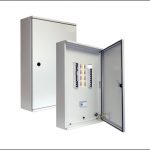Key Features
Application
A distribution board (also known as panel board, breaker panel, or electric panel) is a component of an electricity supply system that divides an electrical power feed into subsidiary circuits, while providing a protective fuse or circuit breaker for each circuit in a common enclosure. Normally, a main switch, and in recent boards, one or more residual-current devices (RCD) or residual current breakers with over current protection (RCBO), are also incorporated.
Power Distribution is a system, consisting of a Main Distribution Board (MDB), Sub Main Distribution Boards (SMDBs) and Final Distribution Boards, by which the electrical energy is transmitted via branches to reach the exact end user.
An MDB is a panel or enclosure that houses the fuses, circuit breakers and ground leakage protection units where the electrical energy, which is used to distribute electrical power to numerous individual circuits or consumer points, is taken in from the transformer or an upstream panel. An MDB typically has a single or multiple incoming power sources and includes main circuit breakers and residual current or earth leakage protection devices. A MDB is comprised of a free standing enclosure, a bus bar system, MCCB’s, metering and support equipments and required current transformers. Panels are assembled in a systematic manner such as incomer section and outgoing section.
Key features of Main Distribution Boards:
Fully type tested assemblies as per IEC 61439-1
Rated up to 6000A
Rated operating voltage up to 690V
Designed for both withdraw able & fixed versions
Ample cabling space for easy connections
Top and bottom cable entry.
Panels for front or rear access to suit application
Index of protection : IP 31 & IP 54
Wall / Floor mounting
Maximum safety & reliability
Customized design to meet end user requirement

